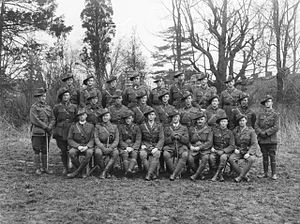39th Battalion (Australia)
| 39th Battalion | |
|---|---|

39th Battalion officers, Belgium, January 1918
|
|
| Active | 1916–1919 1921–1937 1941–1943 |
| Country |
|
| Branch | Australian Army |
| Type | Infantry |
| Size | ~1,000 men all ranks |
| Part of |
10th Brigade, 3rd Division (WWI) 30th Brigade (WWII) |
| Colours | Brown over Red |
| Engagements | |
| Disbanded | 3 July 1943 |
| Commanders | |
| Notable commanders |
William Owen † Ralph Honner |
| Insignia | |
| Unit Colour Patch |  |
The 39th Battalion was an infantry unit of the Australian Army. It was originally raised in February 1916 for service during World War I as part of First Australian Imperial Force, with personnel being drawn mainly from the state of Victoria. Making up part of the 10th Brigade, it was attached to the 3rd Division and served on the Western Front in France and Belgium before being disbanded in March 1919. Following the re-organisation of the Australian Army in 1921, the battalion was raised again in Victoria as a unit of the Citizens Force, becoming known as the "Hawthorn–Kew Regiment". In 1937, it was amalgamated with the 37th Battalion to become the 37th/39th Battalion. Later, in August 1939 it was delinked with the 37th and amalgamated with the 24th Battalion to form the 24th/39th Battalion, before being raised again as a single unit in October 1941.
During World War II the battalion was sent to New Guinea in 1942 as part of the 30th Brigade to defend the territory against a Japanese attack. Subsequently, between July and August of that year the unit was heavily engaged in the defence of Port Moresby, fighting along the Kokoda Track. The 39th fought several desperate actions against the Japanese as they attempted to hold out until further reinforcements could be brought up from Port Moresby. They were also later involved in the fighting around Buna–Gona. Such was their involvement in the battle that by the time they were withdrawn they could only muster 32 men and following its return to Australia, the unit was disbanded in early July 1943.
...
Wikipedia
